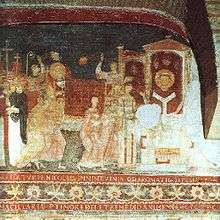Pope Nicholas II
Pope Nicholas II (Latin: Nicholaus II; c. 990/995 – 27 July 1061), otherwise known as Gerard of Burgundy, was bishop of Rome and ruler of the Papal States from 24 January 1059 until his death. At the time of his election, he was bishop of Florence.[1]
Pope Nicholas II | |
|---|---|
| Papacy began | 24 January 1059 |
| Papacy ended | 27 July 1061 |
| Predecessor | Stephen IX |
| Successor | Alexander II |
| Personal details | |
| Birth name | Gerard |
| Born | between 990 and 995 Château de Chevron, Kingdom of Arles |
| Died | 27 July 1061 Florence, Holy Roman Empire |
| Other popes named Nicholas | |
Early life
Gerard of Burgundy was born in Chevron, in what is now Savoy. He was canon at Liege. In 1046 he became bishop of Florence, where he restored the canonical life among the clergy of numerous churches.[2]
Papacy
Benedict X was elected in 1058, his election having been arranged by the count of Tusculum. However, a number of cardinals alleged that the election was irregular, and that votes had been bought; these cardinals were forced to flee Rome. Hildebrand was away on a diplomatic mission to Germany. When he heard of Benedict X's election, he decided to oppose it, and obtained support for the election of Gerard of Burgundy instead. In December 1058, those cardinals who had opposed Benedict X's election met at Siena and elected Gerard as pope instead. He then took the name Nicholas II.[2]
Nicholas II proceeded towards Rome, along the way holding a synod at Sutri, where, in the presence of the Tuscan ruler Godfrey the Bearded and the imperial chancellor, Guibert of Parma, he pronounced Benedict X deposed and excommunicated.[2] The supporters of Nicholas II then gained control of Rome and forced Benedict X to flee to Gerard of Galeria. Having arrived in Rome, Nicholas II then proceeded to wage war against Benedict X and his supporters with Norman assistance. At an initial battle in Campagna in early 1059, Nicholas II was not wholly successful. But later that same year, his forces conquered Praeneste, Tusculum, and Numentanum, and in the autumn took Galeria, forcing Benedict X to surrender and renounce the papacy.
Relationship with the Normans

To secure his position, Nicholas II at once entered into relations with the Normans. The pope wanted to re-take Sicily for Christianity, and he saw the Normans as the perfect force to crush the Muslims.[3] The Normans were by this time firmly established in southern Italy, and later in the year 1059 the new alliance was cemented at Melfi, where the pope, accompanied by Hildebrand, Cardinal Humbert, and Abbot Desiderius of Monte Cassino, solemnly invested Robert Guiscard with the duchies of Apulia, Calabria, and Sicily, and Richard of Aversa with the principality of Capua, in return for oaths of fealty and the promise of assistance in guarding the rights of the Church. This arrangement, which was based on no firmer foundation than the forged "Donation of Constantine", was destined to give the papacy independence from both the Eastern and Western Empires. Its first substantial result was Norman aid in taking Galeria, where Antipope Benedict X was hiding, and the end of the subordination of the papacy to the Roman nobles.
Subordination of Milan
Meanwhile, Nicholas II sent Peter Damian and Bishop Anselm of Lucca as legates to Milan, to resolve the conflict between the Patarenes and the archbishop and clergy. The result was a fresh triumph for the papacy. Archbishop Wido, facing ruinous ecclesiastical conflict in Milan, submitted to the terms of the legates, which subordinated Milan to Rome. The new relation was advertised by the unwilling attendance of Wido and the other Milanese bishops at the council summoned to the Lateran Palace in April 1059. This council not only continued the Hildebrandine reforms by sharpening the discipline of the clergy, but marked an epoch in the history of the papacy by its famous regulation of future elections to the Holy See.
Election reform
Previously, papal elections had effectively been controlled by the Roman aristocracy, unless the Holy Roman emperor was strong enough to be able to intervene from a distance to impose his will. As a result of the battles with the Antipope Benedict X, Nicholas II wished to reform papal elections. At the synod held in the Lateran at Easter, 1059, Pope Nicholas brought 113 bishops to Rome to consider a number of reforms, including a change in the election procedure. The electoral reform adopted by that synod amounted to a declaration of independence on the part of the church. Henceforth, popes were to be selected by the cardinals in assembly at Rome.
See also
References
- Coulombe, Charles A. Vicars of Christ: A History of the Popes, Citadel Press, 2003, p. 210.
- Weber, Nicholas. "Pope Nicholas II." The Catholic Encyclopedia Vol. 11. New York: Robert Appleton Company, 1911. 24 December 2017
- Bartlett, Professor Robert. "The Normans", episode 3, BBC-TV


| Catholic Church titles | ||
|---|---|---|
| Preceded by Stephen IX |
Pope 1059–61 |
Succeeded by Alexander II |